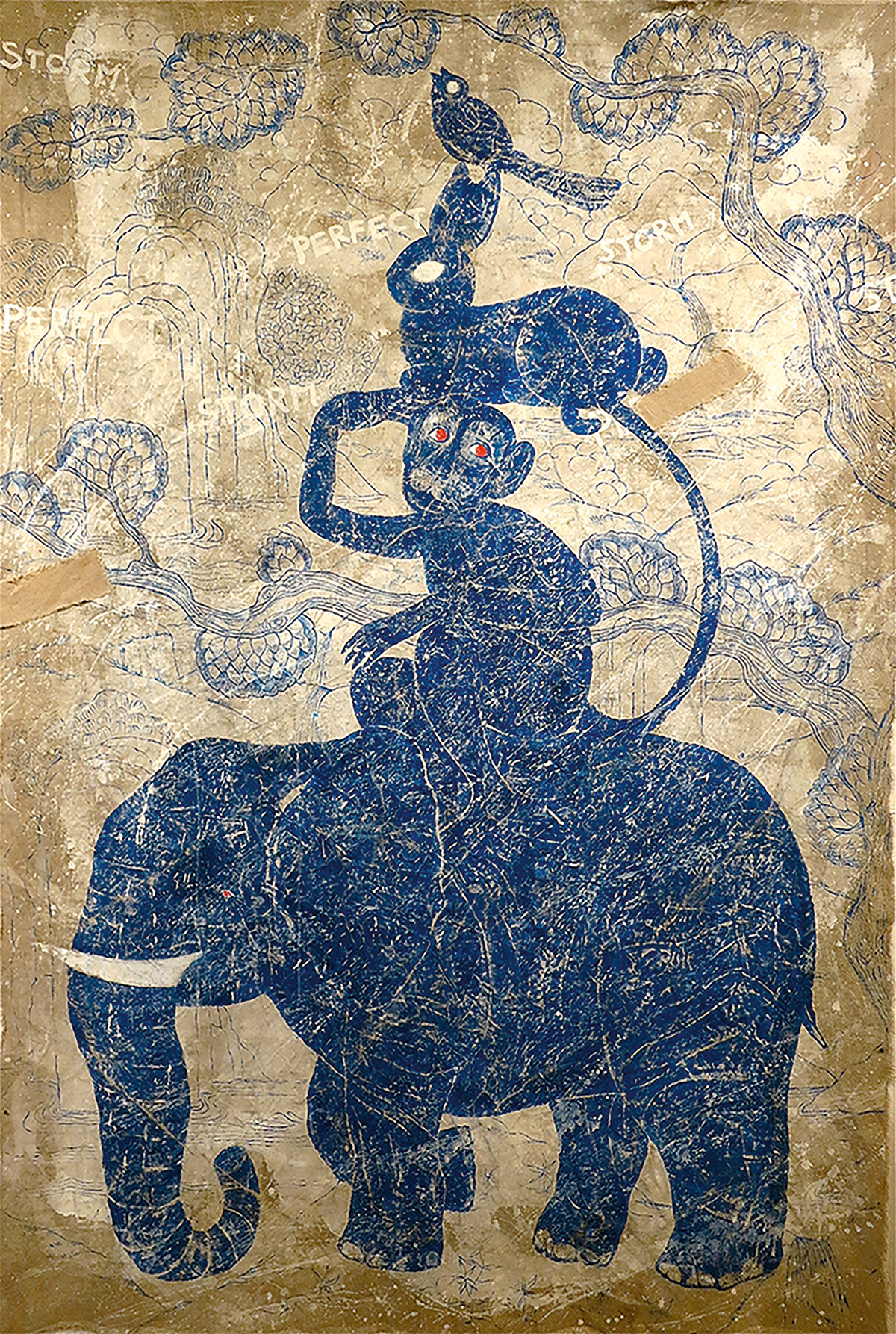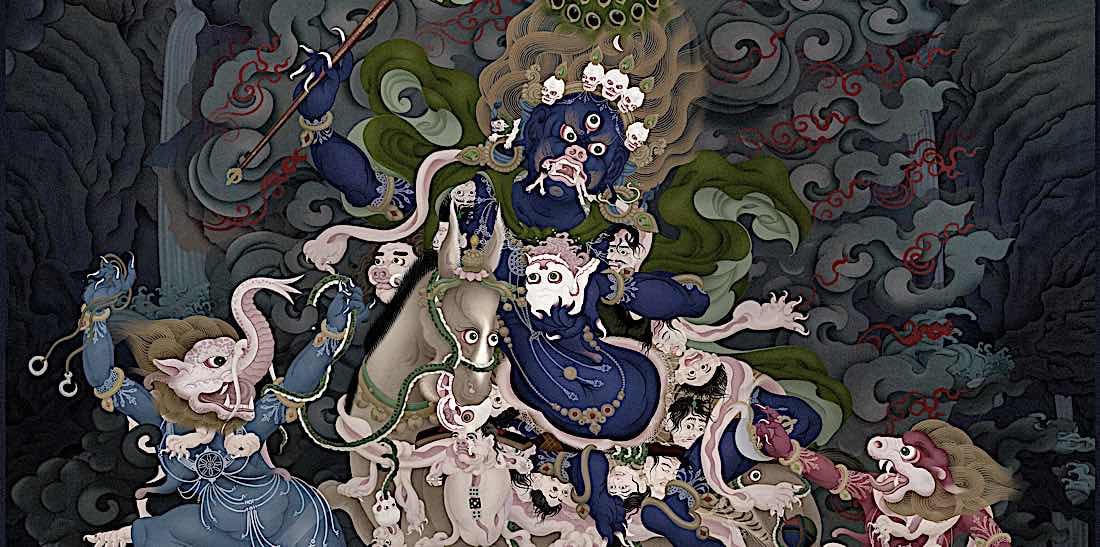10 Steps to Tame the Elephant
For generations, Tibetan practitioners have been guided by a chart outlining the nine stages of samatha meditation. Jan Willis takes us through the map and introduces us to the characters along the way. The post 10 Steps to Tame...

For generations, Tibetan practitioners have been guided by a chart outlining the nine stages of samatha meditation. Jan Willis takes us through the map and introduces us to the characters along the way.

“Perfect Storm,” 2015 by Michaela Martello. Acrylic and gesso on distressed linen.
Though we may have the loftiest of goals, they will come to naught if we have no way of reaching them. We may sincerely wish to help others, to provide what is best for them, to lead all beings from suffering, and so forth, but we cannot accomplish these aims without a means, a path, to do so.
When the Buddha explained the four noble truths in his first discourse, he ended by saying that to accomplish the end of suffering—for ourselves as well as others—we must follow the path (marga) that he had just laid out. The term he used for following and cultivating the path was bhavana, which literally means “to grow, to nourish, to develop,” just as a gardener does her vegetables and flowers.
Such “cultivation” applies to a great variety of practices, but here the Buddha intended that we should cultivate meditation. Another way of saying this is that only wisdom, which directly sees things as they really are, can liberate us from suffering. And for wisdom to mature fully, it needs nourishing by bhavana, or meditative development.
As British scholar Peter Harvey puts it in An Introduction to Buddhism:
Learning meditation is a skill akin to learning to play a musical instrument: it is learning how to “tune” and “play” the mind, and regular, patient practice is the means to this. Progress will not occur if one is lax, but it cannot be forced. For this reason, meditation practice is also like gardening: one cannot force plants to grow, but one can assiduously provide them with the right conditions, so that they develop naturally. For meditation, the “right conditions” are the appropriate application of mind and of the specific technique being used.
In common Buddhist formulations, the terms bhavana, samadhi, and dhyana are often used interchangeably. For example, we frequently hear, especially in Theravada sources, about the “three higher trainings” (adhi-sikshas). These are training in moral discipline (sila), in meditation (samadhi), and in wisdom (prajna). The Mahayana tells us that Buddhist wisdom consists of “three wisdoms.” These are sruta-mayi-prajna, the wisdom that comes from hearing and studying the dharma; cinta-mayi-prajna, the wisdom that arises from reflecting upon what is heard or studied; and bhavana-mayi-prajna, the wisdom that arises from meditating (bhavana) on what is studied and reflected upon.
Regarding the six perfections, or paramitas, the “transcendent activities of a bodhisattva,” the most used term for “meditation” is dhyana, but this term is also glossed as samadhi. Regardless of context, however, all these terms refer to a firm and steady kind of one-pointed meditative concentration. Such steady concentration serves as the basis for, and therefore always precedes, the final and ultimate form of wisdom (prajnaparamita).
All forms of Buddhist meditation, regardless of tradition, consist of two parts: samatha and vipasyana. These two are generally known as concentration and insight, or calm abiding and higher seeing (the insight or wisdom that sees the true nature of reality, which is its impermanence and emptiness). Even simple breathing practices include both elements, for they simultaneously calm and focus the mind as well as reveal to us insights about how the mind operates.
Unlike most Buddhist calm abiding practices, in which the meditator calmly observes and notes without judgment whatever appears to the mind, the Tibetan version of samatha practice calls on meditators to visualize a given object and to develop a firm focus on it, while noticing, and over time dispensing with, gross and then more subtle distractions to concentration.
The Tibetan tradition has developed many engaging stories and analogies for our present predicament as suffering (ignorant) beings. It has some of the best outlines and artistic representations of the cultivation and development of calm abiding practice.
For example, speaking to our current circumstance as suffering beings, the revered Tibetan teacher Chagdud Tulku offered this description of our situation in his book Gates to Buddhist Practice. His words are encouraging, if, initially, also a bit frightening:
Each of us is like someone standing on the edge of a crumbling cliff, the earth rapidly breaking away. If we tell ourselves, “I’m too hot, too tired, too sick, or too busy to do my practice,” it’s like saying we can’t make the effort to move away from the ground that crumbles beneath our feet. …Once we do fully comprehend [the truths of Buddhism], we’ll see the necessity of jumping clear. What’s more, when we see someone else close to the edge and about to fall, we’ll rush to help; we won’t claim we’re too tired or too busy.
Now, if we think about it, controlling our bodies is far easier than controlling our minds. Calm abiding practice calls for us to bring stable control to our minds, yet, almost counterintuitively, we are instructed not to force the mind to settle or relax.
Rather, we’re instructed to calm the mind, initially, by calming the body. We are instructed to relax physically, breathe calmly, and not force anything. As Chagdud Tulku said:
Taming the mind can be likened to taming a wild horse. Instead of tying a horse tightly to a short tether, which might frighten it and cause it to hurt itself trying to get free, we must put it in a very large corral. It’s not really free, but it doesn’t feel confined because it has freedom of movement. As we spend more time with the horse, as it gets to know us and realizes that we’re not going to harm it, it slowly loses some of its fear and we can come closer. As it begins to calm down, we can gradually make the corral smaller.
Once we have calmed the body, we can turn our attention to calming the mind in earnest. Calm abiding (samatha) means centering consciousness and balancing the mind and its mental events, evenly, on a single object. This is called the “one-pointedness of mind.” In the words of Tarthang Tulku in Ways of Enlightenment,
Concentration means the state of being focused and calm, unscattered, and undistracted…. [It] increases the capacity of the mind to see directly how the self operates, how “I” and emotions arise. Deep concentration penetrates to the level of consciousness where these emotions originate and develops stability that does not waver as emotions surface. This stability is essential for clear observation and for generating the confidence to disengage from harmful patterns.
The gZhi-gnas Path
In Tibetan, the term for “calm abiding” is gZhi-gnas (pronounced Zhi-nay), which means “dwelling, or abiding, in peace.” The Tibetan practice to accomplish concentration or one-pointedness is a quite specific technique, and Tibetans Buddhists have developed a well-known graphic guide to its stages of development.
During the 1970s and 1980s, I saw an illustration of this path on the walls of monks’ cells throughout India and Nepal. Whenever and wherever I visited with Tibetan monks in their monastery rooms, I saw this diagram. It was, along with images of various deities, their personal yidams, and calendars, one of the most ubiquitous wall decorations. All the monks regularly used the diagram or had studied it in the past. It was kept and displayed for its practical and pragmatic advice, offering a specific antidote for each problem that might arise in their concentration practice.
In my experience, no other chart or illustration of the path of meditation offered such readily available and detailed explication. In 1970, I had the fortunate opportunity to study and practice the “Stages of gZhi-gnas” diagram under the renowned lama Geshe Rabten. Let’s look closely at this famed illustrated guide and the analysis of the “Path of Calm Abiding” it details.
The Characters
There are four main “characters” depicted on the chart: the monk, who represents the meditator; the monkey, who stands for obvious distractions; the rabbit, who appears only at stage three and who represents the more subtle obstacles to concentration; and the elephant, who stands for our mind.
Why is the elephant the symbol for our mind? Geshe Rabten once told me (in my book The Diamond Light) that the elephant is used for several reasons:
First, if an elephant is wild, it is very dangerous to all other animals. Likewise, if the mind is not controlled, it can harm others. All suffering is caused by an untamed mind. Second, if an elephant is tamed, he obeys his master better than any other animal. Even if the master says to pick up a very large hot ball with its trunk, the elephant will do it. If the mind is once tamed, it can perform any action, no matter how difficult. Third, the footprint of the elephant is larger than any other animal’s print. If our mind is tamed and comes under the control of the dharma, it serves its master better than any other thing. If our mind is very peaceful and well tamed, for example, there will no longer be any enemies of that person anywhere. If our mind is peaceful, we make all others around us peaceful. All the results of our mind—whether good or bad—are greater. The body and speech of a person are only servants of the mind.
Many other great Buddhist thinkers and meditators of the past also made use of the elephant analogy. Maitreyanatha, Asanga, Kamalashila, and Tsongkhapa all employed it. The great eighth-century sage and poet Shantideva also referred to the idea of the elephant when he wrote in The Way of the Bodhisattva of the importance of taming our “elephant-mind”:
1. Those who wish to keep a rule of life
Must guard their minds in perfect self-possession.
Without this guard upon the mind,
No discipline can ever be maintained.
2. Wandering where it will, the elephant of mind
Will bring us down to pains of deepest hell.
No worldly beast, however wild,
Could bring upon us such calamities.
3. If, with mindfulness’ rope,
The elephant of the mind is tethered all around,
Our fears will come to nothing,
Every virtue drop into our hands.
4. Tigers, lions, elephants, and bears,
Snakes and every hostile beast,
Those who guard the prisoners in hell,
All ghosts and ghouls and every evil phantom,
5. By simple binding of this mind alone,
All these things are likewise bound.
By simple taming of this mind alone,
All these things are likewise tamed.
An ideal outcome if we can attain it!
The Obstacles and Antidotes
The monk in the diagram holds two items: a rope or lasso, which stands for remembrance, and a hook, which symbolizes watchfulness.
The fire on the diagram represents the energy for meditation. (Note that it blazes at the early stages of this practice and lessens as one’s concentration grows, thereby requiring less energy.) In very detailed depictions of this path, there is also a conch (or a cloth), cymbals, a mirror, perfume, and fruit. These five represent the sense objects, since during meditation the mind is easily distracted by the objects of sense.
The elephant, monkey, and rabbit (when it appears) are all initially depicted as being black. This represents the dullness, heaviness, or sinking of the beginning meditator’s mind. The color gradually lightens as the meditator progresses through the practice.
For each of the possible obstacles to the practice, there is a specific antidote or remedy suggested. For example, it is said that there are two types of “scattering”—toward sense objects and toward feelings and emotions. One remedy for scattering is to stop concentrating on the object and to practice a quick breathing exercise. Another is to meditate on the sufferings of samsara. If neither of these helps, the advice is to get up and take a brief walk.
If sinking or weakness is an obstacle, the suggested remedies are to meditate on “happy things,” to think about the virtues of meditation, or to visualize white light like the moon or some bright object. If these don’t help, the instruction is to get up and “wash the head.” The forms of distraction each become progressively less dark and more light-colored as the meditation itself progresses.
The Stages of the Path
In the first stage of the path, the beginning of the concentration “chase,” the monkey is shown leading the elephant. This represents the mind being led around by distractions of various kinds. As renowned thangka painter Andy Weber comments:
A monkey cannot keep quiet for a moment—it is always chattering or fidgeting and finds everything attractive. Just as the monkey is in front leading the elephant, our attention is distracted by sensory objects of taste, touch, sound, smell, and vision. These are symbolized by food, cloth, musical instruments, perfume, and a mirror. The person behind the elephant represents the meditator trying to train the mind. The rope in the meditator’s hand is mindfulness, and the hook is awareness. Using these two tools, the meditator will try to tame and control his mind.
In the second stage, both the elephant and the monkey begin to have light spots on their heads, though the monk is still behind them, as he has little control over them.
In the third stage, the monk–meditator has thrown his lasso around the elephant’s head, and both the elephant and the monkey turn their heads back toward the meditator. The rabbit appears here for the first time, indicating that the meditator “notices” for the first time the more subtle forms of distractions.
In stage four, the bodies of all three misbehaving animals have become half white, though the monk–meditator still is led by them. In the fifth stage, the meditator has gotten out in front and is at last leading the animals.
In stage six of the path, the rabbit has disappeared, the elephant and monkey are about two-thirds white, and the monkey of distraction is being led by the elephant-mind. The meditator no longer even needs to look at them; he or she now faces forward. Commenting on this part of the diagram, Weber notes, “This means that the practitioner does not have to focus continually on controlling the mind, and the absence of the rabbit shows that the subtle dullness, which appeared at the third stage, has now disappeared.”
In the seventh stage, we note that the elephant-mind can be left to follow on its own. The monk does not need to hold it tightly or guide it; both the lasso and the hook have disappeared. Distracted attention, the monkey, and dullness, the rabbit, occur only occasionally.
In stage eight, the elephant has turned completely white and follows behind the meditator. Weber points out, “This shows that the mind is obedient and there is no sinking or scattering, although some energy is still needed to concentrate. At the ninth stage, the practitioner can sit in meditation while the elephant sleeps peacefully nearby; at this point the mind can concentrate without effort for long periods of time—days, weeks, or even months.”
Geshe Rabten was even more specific about the lengths of time for which such one-pointed concentration can be maintained. He said that, at stage four, “concentration on the object is possible for a maximum of fifteen minutes, without any distraction,” but by the fifth stage, “fixed concentration for more than half an hour is possible.” He noted that from the fifth stage on, “the object is very clear, very ‘close’ to the mind, and the mind is peaceful, with no distractions… From this stage on, the meditator can see the object of concentration much clearer than with his two eyes!”
At stage six, he noted, “when the monk is not even looking at the elephant, concentration without any disturbance is possible for at least one hour.” At the seventh stage, “after long practice…no energy is needed; concentration comes immediately…and is possible for about four hours.” At stage eight, which is called “to make one-pointed,” Geshe Rabten said that “there is automatic concentration until the meditator wishes to stop it.” He noted, “At this stage, one’s other senses do not operate as well or at all…. Concentration for one or two days without a break is possible.”
And then we come to stage nine, called “to put equally.” Here the monk meditates, and the elephant just sleeps. According to Geshe Rabten, “At this stage there is no limit to the length of fixed concentration…. The meditator is totally nondependent upon the senses. For example, he needs no food. The scriptures mention that at this stage, the meditator uses only ‘the food of samatha.’”
The Fruit of the Path
Geshe Rabten opined that “Many people mistake [stage nine] as the goal of gZhi-gnas itself. But all these nine stages are only the path to gZhi-gnas; they are not really gZhi-gnas. The real gZhi-gnas is reached at the tenth stage, when the monk is sitting astride the elephant.”
Geshe Rabten noted that after the ninth stage is attained, many new and extraordinary experiences come “which have never been experienced before. When these experiences come, this is the sign that gZhi-gnas has been attained…. Not only when meditating, but in all actions, the one possessed of gZhi-gnas is in full concentration. His/her body feels like the wood–wool flower or like a Mimosa blossom. All supernatural powers—such as reading the minds of others, disappearing, and others arise.”
But none of these things is the goal. Geshe Rabten continued, “Like someone who has ‘sharpened the axe to cut all things,’ the meditator now is capable of doing any other meditative practice. The miraculous powers are not important things…. One has to train for investigation. This is called ‘higher seeing’ (vipasyana; Tibetan, lhag-thong). It may be called adi-gZhi-gnas.”
In the diagram, the activation of extraordinary powers is represented by the monk–meditator flying in the air. The very last “stage” depicted here is the monk–meditator seated atop the elephant, heading back around, holding aloft a sword, the common symbol of the Buddha’s wisdom.
This means the meditator is now fully prepared to take on the meditations for gaining vipasyana, or higher seeing, by means of which they will seek to realize the nature of reality itself. The flames of energy for this new meditation flare up again strongly. (A tantric commentary adds that “the flying monk represents bodily bliss; and his riding the elephant, mental bliss.”)
Geshe Rabten summarized the practice journey like this: “These are the two indispensable things for higher practice, for abandoning delusion. If one wants to cut a tree, he must have both a strong arm (gZhi-gnas) and a good axe (lhag-thong). After sharpening an axe, a person must use it. After taming the mind in gZhi-gnas, one must use it for higher practice. We must use it for the attainment of enlightenment! We must ourselves become Buddha!”
We might ask, “Is the special kind of one-pointed concentration entailed by the Stages of Samatha really necessary? Can’t we just focus as well as we can, and have that be enough?” Of course, we must each answer for ourselves. But if we sincerely and truly wish to practice in earnest, to gain wisdom to free ourselves and others from suffering, we need to give some serious attention to developing samatha early on. For, ultimately, as Shantideva remarked,
All the recitations and austerities,
even though performed for a long time,
are actually quite useless
if the mind is dull or is focused on something else.

 ShanonG
ShanonG 
































